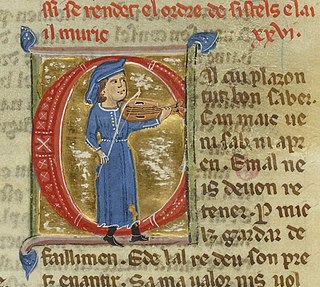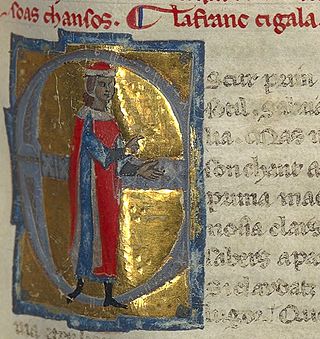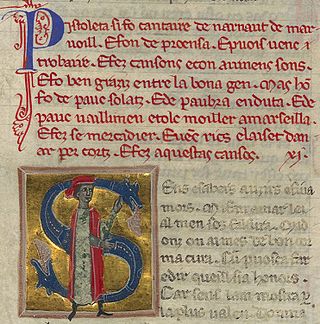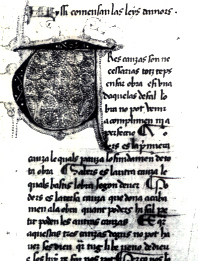Sources
- Riquer, Martín de. Los trovadores: historia literaria y textos. 3 vol. Barcelona: Planeta, 1975.
Matieu de Caersi, Caerci, or Querci was a troubadour from the Quercy. According to the rubric accompanying his only song in troubadour manuscript C, [1] he was Mayestre Matieus de Caersi, that is, a Master of Arts from Quercy, possibly Cahors. He is not to be identified with the Matheus who composed a tenso with Bertram de Gordon in 1212.
Matieu's lone surviving song is Tant suy marritz que no.m puese alegrar ("I am so afflicted that I cannot be happy"), a planh on the death of James I of Aragon (died 26 August 1276). It is often compared and contrasted with another planh on James' death composed by Cerverí de Girona, Si per tristor, per dol no per cossir. Cerverí's piece is direct and almost personal, as the troubadour asks the Virgin Mary to show as much mercy to James as he showed on earth, referring to his establishing the Mercedarian Order in Barcelona. Matieu, on the other hand, is moralising and religious. He is also self-concerned, as he asks James' sons to continue to protect him. The merits of both works have been debated by critics.
Structurally, Matieu imposes coblas capfinidas on what is otherwise the metric and rhyme form used by Raimbaut de Vaqueiras in Ara pot hom conoisser e proar. The pieces also has two tornadas . The first plays on the fact that James died a day after the feast day of James, son of Zebedee (Santiago Matamoros): de dos Jacmes dobla festa.ns remanha [Dieu] ("from two James God has given us a double festival"). Earlier Matieu had compared the sorrow of the people of James' lands as like that of the Britons bemoaning the loss of King Arthur: ben devetz aitant de dol aver cum per Artus agron silh de Bretanha.

A troubadour was a composer and performer of Old Occitan lyric poetry during the High Middle Ages (1100–1350). Since the word troubadour is etymologically masculine, a female troubadour is usually called a trobairitz.

Bertran de Born was a baron from the Limousin in France, and one of the major Occitan troubadours of the 12th-13th century. He composed love songs (cansos) but was better known for his political songs (sirventes). He was involved in revolts against Richard I and then Phillip II. He married twice and had five children. In his final years, he became a monk.
A planctus is a lament or dirge, a song or poem expressing grief or mourning. It became a popular literary form in the Middle Ages, when they were written in Latin and in the vernacular. The most common planctus is to mourn the death of a famous person, but a number of other varieties have been identified by Peter Dronke. The earliest known example, the Planctus de obitu Karoli, was composed around 814, on the death of Charlemagne.

Pons de Capduelh was a troubadour from the Auvergne, probably from Chapteuil. His songs were known for their great gaiety. He was a popular poet and 27 of his songs are preserved, some in as many as 15 manuscripts. Four of his cansos survive with musical notation.

Lanfranc Cigala was a Genoese nobleman, knight, judge, and man of letters of the mid thirteenth century. He remains one of the most famous Occitan troubadours of Lombardy. Thirty-two of his poems survive, dealing with Crusading, heresy, papal power, peace in Christendom, and loyalty in love. Lanfranc represented a tradition of Italian, Occitan-language trovatori who berated the Papacy for its handling of the Crusades.
En Johan Esteve de Bezers, in modern orthography Joan Esteve, was a troubadour from Béziers. The only chansonnier which contains his eleven works, also calls him Olier de Bezers, implying that he was perhaps a potter. All his works are accompanied by dates of composition which allows scholars to place his literary output between 1270 and 1288.

Aimeric de Belenoi was a Gascon troubadour. At least fifteen of his songs survived. Seven others were attributed to him in some medieval manuscripts.

Uc Brunet, Brunec, or Brunenc was a nobleman and troubadour from Rodez in the Rouergue. Six of his works survive.
Hugh IV, of the House of Millau, was the Count of Rodez and Viscount of Carlat and Creyssel from 1221 until his death. He was the son of Henry I of Rodez and Algayette of Scorailles.
Raimon Gaucelm de Bezers was a Languedocian troubadour with nine surviving works. Many of his works appear with dates in the rubrics in manuscript C, a 14th-century work now "BN f.f. 856" in the Bibliothèque nationale de France, Paris, allowing his career to be dated with ease.

Cerverí de Girona was a Catalan troubadour born Guillem de Cervera in Girona. He was the most prolific troubadour, leaving behind some 114 lyric poems among other works, including an ensenhamen of proverbs for his son, totaling about 130. He was a court poet to James the Conqueror and Peter the Great. He wrote pastorelas and sirventes and his overriding concern was the complexities of court life. None of his music survives.
Paulet de Marselha was a Provençal troubadour from Marseille. Three of his eight surviving works are dedicated to Barral dels Baus, the viscount of Marseille. Three were love songs composed in Marseille during an era of peace. While his patron Barral eventually came to support Charles of Anjou as Count of Provence and followed him into wars in Italy, where he died, Paulet was opposed Angevin dominance of Provence and was deprived of his possessions and forced to flee, becoming a faidit in Catalonia.
Bernart de Rovenac, Rovenhac, or Roenach was a Languedocian troubadour. Four of his sirventes have been preserved. The attitude ubiquitous in his poetry is perhaps best expressed by these lines: Aital guerra m'agrada mas que platz, / non tals treguas ont om si'enganatz.

Pistoleta was a Provençal troubadour. His name means "little letter (epistle)" in Occitan. He left behind eleven songs, comprising nine cansos and two tensos. Some of his pieces are assigned to an otherwise unknown Jordan de Born in the table of contents of chansonnier C, a fourteenth-century Occitan manuscript.
Huguet de Mataplana was a Catalan nobleman and poet. His name, also spelled Uget, is the diminutive form of Hug, which is the Occitan version of "Hugh".
Austorc de Segret or Austau de Segret was an Auvergnat troubadour with only one surviving sirventes, "No sai quim so, tan sui desconoissens".

The Consistori del Gay Saber was a poetic academy founded at Toulouse in 1323 to revive and perpetuate the lyric poetry of the troubadours.
The Consistoride Barcelona was a literary academy founded in Barcelona by John the Hunter, King of Aragon and Count of Barcelona, in 1393 in imitation of the Consistori del Gay Saber founded in Toulouse in 1323. The poetry produced by and for the Consistori was heavily influenced by the troubadours. The Consistori's chief purpose was to promote "correct" styles and themes and discourage vices (vicis) by awarding prizes in competition to poets who adhered to the "rules" of poetic composition. The names of few poets laureate have come down to us and despite some excellent descriptions of the Consistori's activities, associated persons and poems are obscure.
Nationality words link to articles with information on the nation's poetry or literature.